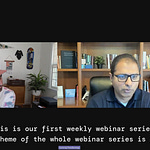Listen now on Apple, Spotify, Overcast, Google and YouTube.
In this insightful episode, we explore the world of Product-Led Growth (PLG) Infrastructure, a key element for SaaS companies at various stages of their journey. Featuring the seasoned expertise of Hila Qu, this podcast provides a comprehensive overview of the intricacies involved in constructing a solid PLG foundation, vital for fostering sustainable growth in the competitive SaaS landscape.
This podcast builds upon Lenny's Newsletterblog post fromHila Qu 曲卉 titled - Five steps to starting your product-led growth motion and focuses mostly on the PLG Infrastructure that Startups need to build and manage for implementing growth strategies.
Early Stage: Finding the Product-Market Fit
At the onset, startups grapple with identifying their market fit. Here, PLG plays a pivotal role, offering a low-touch yet high-impact approach to understanding and catering to customer needs.
User Experience Design: Ensuring the product is intuitive and offers immediate value.
Data-Driven Strategy: Utilizing Salesforce for CRM and Amplitude for analytics to translate user interactions into actionable insights.
Team Composition: Forming a dynamic, cross-functional team combining product design, marketing intelligence, and data analysis.
Growth Stage: Refining and Expanding
As companies transition to the growth stage, the focus shifts to refining the PLG strategy. This phase is marked by enhanced customer engagement and sophisticated product offerings, laying the groundwork for a broader market reach.
Deeper Data Analysis: Using sophisticated analytics tools for an in-depth understanding of customer behavior.
Strategic CRM Integration: Managing and nurturing the expanding customer base.
Monetization Approaches: Experimenting with various models to identify the most effective strategies for different segments.
Scale Stage: Maximizing Reach and Efficiency
In the scale stage, SaaS companies fully leverage PLG infrastructure to maximize market penetration. Advanced tooling and strategies come into play, streamlining processes and scaling operations efficiently.
Enhanced Tooling and Data Platforms: Implementing CDPs for a centralized customer data view and leveraging AB testing for product optimization.
Strategic Team Composition: Forming dedicated growth teams and emphasizing the leadership role in championing PLG.
Data-Driven Decision Making: Adapting and evolving strategies effectively based on market and user feedback.
Throughout these stages, an underlying shift towards a hybrid growth model emerges, blending the strengths of PLG with Sales-Led Growth (SLG) strategies. This nuanced transition forms the backbone of sustainable and scalable growth in the SaaS domain.
Key Timestamps:
(00:02) Introduction and the role of PLG in AI product development.
(01:01) Overview of Hila Qu's background and her insights on PLG infrastructure.
(02:39) Discuss the trends in PLG infrastructure and its adoption by early-stage startups.
(04:01) Challenges faced by early-stage startups in implementing PLG and the necessary infrastructure.
(07:37) The importance of PLG in the scaling process of startups.
(10:00) Debunking the myth that PLG should start only after achieving PMF (Product-Market Fit).
(12:26) Recommendations for early-stage startups on building a PLG infrastructure.
(17:09) Team composition and leadership roles in implementing PLG strategies.
(21:13) Transitioning from the early stage to the scaling phase in PLG implementation.
(26:08) Advanced tooling and strategies for startups in the scaling phase.
(31:25) Final insights and closing remarks.
Where to Find the Guest:
LinkedIn: Hila Qu
Where to Find the Host:
LinkedIn: Gururaj Pandurangi














